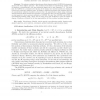79 search results - page 5 / 16 » Equivalent Number of Degrees of Freedom for Neural Networks |
ESANN
2001
13 years 8 months ago
2001
Prediction of financial time series using artificial neural networks has been the subject of many publications, even if the predictability of financial series remains a subject of ...
ISTCS
1993
Springer
13 years 11 months ago
1993
Springer
We pursue a particular approach to analog computation, based on dynamical systems of the type used in neural networks research. Our systems have a xed structure, invariant in time...
SIAMNUM
2010
13 years 2 months ago
2010
We analyze an adaptive discontinuous finite element method (ADFEM) for symmetric second order linear elliptic operators. The method is formulated on nonconforming meshes made of si...
ESANN
2006
13 years 8 months ago
2006
Quantifying the success of the topographic preservation achieved with a neural map is difficult. In this paper we present Topological Correlation, Tc, a method that assesses the de...
ACSC
2008
IEEE
13 years 9 months ago
2008
IEEE
Recurrent neural networks are able to store information about previous as well as current inputs. This "memory" allows them to solve temporal problems such as language r...

